Immunization serves as the most effective shield against the fowl pox disease.
Preventing Fowl Pox in Poultry: The Importance of Vaccination and Biosecurity
Fowl pox, a disease caused by the Poxviridae virus, can pose a significant threat to poultry farms. This disease is rare in broilers and common during the rainy season with high insect populations, often spreading through biting or sucking insects that have come into contact with infected birds.
The good news is that effective control and prevention of fowl pox primarily involve vaccination, biosecurity measures, and isolation of affected birds.
Vaccination
The most effective prevention is vaccination with a live, chicken embryo propagated, freeze-dried vaccine administered via the wing-web method. Vaccination is recommended for healthy chickens aged 8 weeks or older, ideally at least 4 weeks before they start laying eggs. This vaccine helps prevent clinical signs caused by virulent field strains of fowl pox virus.
To ensure lifelong immunity, it's advisable to vaccinate hatcheries' breeders, particularly those from hatcheries that routinely vaccinate their breeders against fowl pox.
Isolation
Immediately separating affected chickens helps prevent the spread of the virus to the rest of the flock, reducing outbreak severity.
Biosecurity
Maintaining strict biosecurity practices such as controlling mosquitoes and mechanical vectors (since fowl pox can be spread by mosquitoes and direct contact), disinfecting equipment and housing, and minimizing stress to birds supports prevention.
General Care
Good flock management with proper nutrition and minimizing environmental stress also aids resistance to infection and supports recovery.
It's essential to note that there is no cure for fowl pox once birds are infected; management relies on supportive care and preventing secondary infections. Topical antibiotic treatment can be used if a vet advises, as in 30% of clinical cases, complications with bacterial infections may occur.
Taking Action
Dr. Messo, the company veterinarian at Kenchic, emphasizes the importance of these measures. If you have any questions or concerns, you can reach him at [email protected].
In summary, routine vaccination, along with strict biosecurity and isolation of infected birds, are the most effective and widely recommended control and prevention measures for fowl pox in poultry. By implementing these practices, farmers can protect their flocks and maintain healthy, productive poultry farms.
- Reading up-to-date news on health-and-wellness section of an epaper can provide farmers with valuable information about the latest vaccination schedules for fowl pox, helping them protect their flocks effectively.
- In addition to vaccination and biosecurity, regular exercise and fitness-and-exercise routines are important aspects of maintaining overall health in poultry, as it boosts their immune systems and helps them cope with stress.
- While sports may not have an apparent connection, understanding the strategies and teamwork that successful poultry farms implement can serve as an inspiring model for farmers striving to achieve optimal biosecurity and disease prevention on their own farms.




